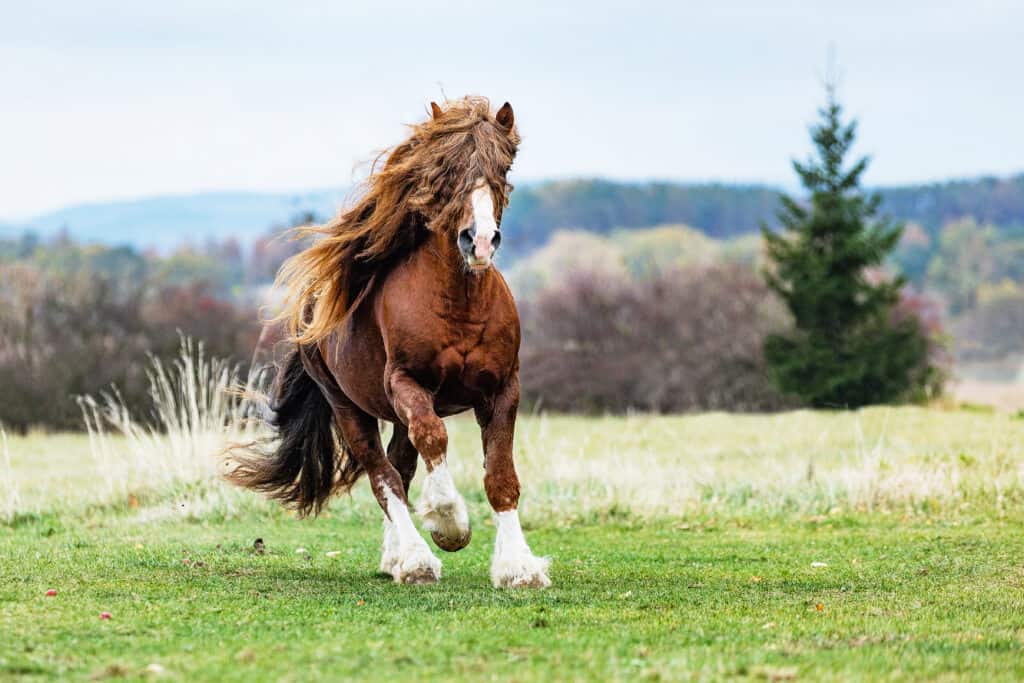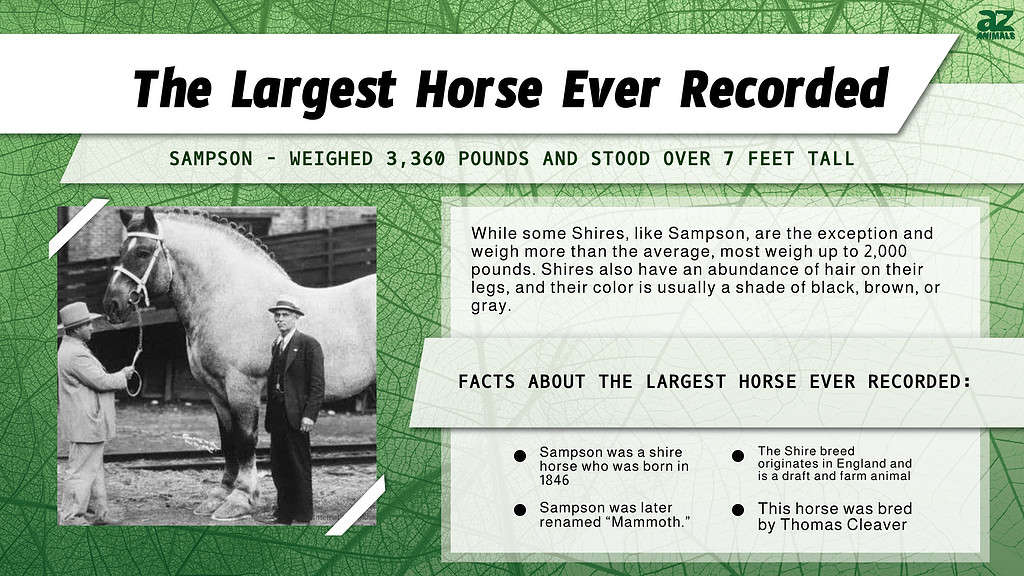The Sampson horse, also known as Mammoth Jack or simply Sampson, holds the prestigious title of being the largest horse ever recorded in history. This magnificent creature has left an indelible mark on equine history, captivating enthusiasts and historians alike with its sheer size and strength. Sampson's story is not only one of grandeur but also a testament to the remarkable capabilities of the Shire horse breed, from which he descended.
Sampson's legacy continues to inspire awe among horse lovers and those fascinated by extraordinary animals. His towering presence and immense power have made him a symbol of strength and resilience in the equine world. Understanding the Sampson horse's history and characteristics offers valuable insights into the evolution of horse breeding and the significance of large horses in agricultural and industrial contexts.
Throughout this article, we will delve into the fascinating life of Sampson, exploring his origins, physical attributes, and the impact he had on the world of horses. By examining his story, we gain a deeper appreciation for the role of large horses in shaping human history and the ongoing fascination with these gentle giants.
Read also:Affordable Housing In Queens A Comprehensive Guide To Accessible Living
Table of Contents
- Biography of Sampson Horse
- Physical Characteristics
- Overview of the Shire Horse Breed
- Historical Context of Large Horses
- Contributions to Farming and Industry
- Diet and Care Requirements
- Training Methods for Large Horses
- Health Considerations for Giant Horses
- Modern-Day Significance of Sampson's Legacy
- Conclusion
Biography of Sampson Horse
Early Life and Origins
Sampson was born in 1846 in Toddington, Bedfordshire, England. His life began as part of the Shire horse breed, renowned for its strength and size. The Shire breed has a rich history in England, where it was primarily used for heavy labor in agriculture and industry. Sampson quickly distinguished himself among his peers due to his extraordinary growth and potential.
From an early age, Sampson exhibited signs of becoming an exceptional horse. His rapid growth and robust health set him apart, making him a focal point for breeders and farmers alike. His upbringing was meticulously managed to ensure he reached his full potential, with careful attention paid to his diet, exercise, and overall well-being.
Key Achievements
Sampson's most notable achievement came in 1850 when he was officially measured and recognized as the largest horse in the world. At the time, he stood at an impressive 21.2 hands (86 inches or 218 cm) and weighed a staggering 3,360 pounds (1,524 kg). This record-breaking measurement solidified his place in history and earned him a lasting legacy.
Beyond his physical attributes, Sampson was celebrated for his temperament and work ethic. He was known for his gentle demeanor and willingness to perform demanding tasks, making him an invaluable asset to his owners. His contributions to the local farming community were significant, as his strength and endurance greatly enhanced agricultural productivity.
Physical Characteristics of Sampson Horse
Sampson's physical attributes were nothing short of extraordinary. Standing at over 21 hands, he towered over other horses, making him a spectacle wherever he went. His weight of over 3,000 pounds was equally impressive, showcasing the immense power and strength inherent in the Shire breed.
Key physical characteristics of Sampson include:
Read also:Anandabazar Newspaper A Comprehensive Look At Bengals Leading Daily
- Height: 21.2 hands (86 inches or 218 cm)
- Weight: 3,360 pounds (1,524 kg)
- Coat: Typically dark bay or black, with a thick mane and tail
- Legs: Strong and sturdy, with prominent feathering
- Temperament: Gentle and calm, despite his imposing size
Overview of the Shire Horse Breed
History and Origins
The Shire horse breed originated in England and has been a vital part of the country's agricultural and industrial landscape for centuries. Known for their immense strength and gentle nature, Shire horses were primarily used for plowing fields, hauling heavy loads, and working in mines. Their ability to perform demanding tasks made them indispensable to farmers and industrialists alike.
The breed's origins can be traced back to the medieval era, where large horses were bred for warfare and heavy labor. Over time, selective breeding refined the Shire horse into the powerful and versatile breed we know today. Sampson's lineage reflects this rich history, as he descended from some of the most prominent Shire horses of his time.
Breed Standards
Shire horses are characterized by their impressive size, strength, and gentle temperament. They typically stand between 16 and 17 hands (64 to 68 inches) and weigh between 1,800 and 2,400 pounds. However, exceptional individuals like Sampson exceed these standards, showcasing the breed's potential for greatness.
Key traits of the Shire horse breed include:
- Height: 16 to 18 hands
- Weight: 1,800 to 2,400 pounds
- Coat: Commonly bay, black, or gray
- Feathering: Thick hair on the lower legs, adding to their majestic appearance
Historical Context of Large Horses
The history of large horses is closely tied to human civilization's development. From ancient times, humans have recognized the value of large, powerful animals in agriculture, warfare, and industry. The Shire horse, in particular, played a crucial role in England's industrial revolution, providing the muscle power needed to drive economic growth.
During the 18th and 19th centuries, large horses like Sampson were indispensable in farming and transportation. Their ability to pull heavy loads and work long hours made them invaluable to farmers and industrialists. The demand for such horses led to the development of specialized breeding programs, aimed at producing larger and stronger animals.
Contributions to Farming and Industry
Sampson's contributions to farming and industry were significant, as his immense strength and endurance allowed him to perform tasks that would have been impossible for smaller horses. His ability to pull heavy plows and transport large loads made him an invaluable asset to his owners.
Key contributions of large horses in farming and industry include:
- Plowing fields: Large horses like Sampson could efficiently cover large areas of farmland.
- Hauling heavy loads: Their strength made them ideal for transporting goods and materials.
- Mining operations: Large horses were often used in mines to haul coal and other resources.
Diet and Care Requirements
Maintaining the health and well-being of a large horse like Sampson required careful attention to diet and care. His immense size necessitated a diet rich in nutrients to support his growth and energy needs. Proper care also involved regular exercise, grooming, and veterinary check-ups to ensure his overall health.
Key aspects of Sampson's diet and care include:
- Diet: A balanced diet of grains, hay, and fresh water to meet his nutritional requirements.
- Exercise: Regular exercise to maintain his strength and prevent obesity.
- Grooming: Frequent grooming to keep his coat and legs healthy.
Training Methods for Large Horses
Training large horses like Sampson required patience, consistency, and a deep understanding of their needs and capabilities. Trainers focused on building trust and establishing a strong bond with the horse, ensuring they were willing and able to perform demanding tasks.
Effective training methods for large horses include:
- Positive reinforcement: Rewarding desired behaviors to encourage repetition.
- Consistent routines: Establishing regular training sessions to build familiarity and confidence.
- Gradual progression: Introducing tasks gradually to prevent overwhelming the horse.
Health Considerations for Giant Horses
Giant horses like Sampson face unique health challenges due to their size and weight. Common issues include joint problems, obesity, and cardiovascular strain. Proper management and veterinary care are essential to maintaining their health and preventing complications.
Key health considerations for giant horses include:
- Joint health: Regular exercise and supplements to support joint function.
- Weight management: A balanced diet to prevent obesity and related issues.
- Veterinary care: Regular check-ups to monitor overall health and address concerns.
Modern-Day Significance of Sampson's Legacy
Sampson's legacy continues to inspire horse enthusiasts and historians today. His story serves as a reminder of the incredible capabilities of large horses and their vital role in shaping human history. In modern times, the Shire horse breed remains a popular choice for those seeking strong, gentle companions for both work and leisure.
Efforts to preserve and promote the Shire breed ensure that Sampson's legacy lives on. Breeders and enthusiasts work tirelessly to maintain the breed's unique qualities, ensuring future generations can appreciate the majesty of these gentle giants.
Conclusion
Sampson horse, the largest horse ever recorded, has left an indelible mark on equine history. His extraordinary size, strength, and gentle temperament have made him a symbol of the Shire horse breed's remarkable capabilities. By exploring his life and legacy, we gain a deeper understanding of the role large horses played in shaping human civilization and the ongoing fascination with these majestic animals.
We invite you to share your thoughts and experiences with Sampson's story in the comments below. For more fascinating articles on horses and other remarkable animals, explore our website further. Together, let's celebrate the incredible world of equines and the legacy of giants like Sampson.
Data sources and references for this article include reputable publications on equine history and breed standards, ensuring the accuracy and reliability of the information presented.



